
THROUGH THE
SIEGFRIED
| Little more than two miles north of Wissembourg
the main line of German heavy fortifications--the Siegfried Line or Westwall--faced the
Allied invaders as they plunged into Germany. As they had done all along the western
border of Germany, German engineers at Wissembourg Gap had arranged a formidable defense,
heaviest in the entire Seventh Army sector, to block this natural gateway to the
Fatherland. Here the country is but slightly rolling and open, excellent for armor,
flanked on the west by a jumbled mass of sharply rising, forested hills. The 36th
Division, farthest in point of distance from the Siegfried on the March 15 jump-off line,
and not provided with armored siege guns, was expected to do little more than make a
serious demonstration upon reaching the obstacle - to uncover the Siegfried defenses -
while the Army's main effort was delivered at closer range many miles to the Division
left. But, after planting the Lone Star flag on the Schweigen customs house, T-Patchers
smashed on through this hard core of the Westwall, taking to the hills in a strenuous
pillbox-to-pillbox advance, and reducing the enemy's most violent opposition. |
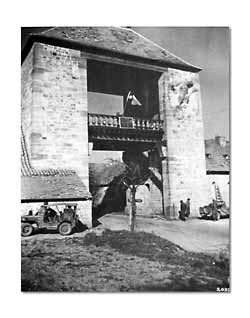
| Texas flag flies over Germany. At the monumental customs house
gateway at Schweigen, the Texas Lone Star flag, sent by Governor Coke Stevenson, was
planted by Division MPs. The hastily chalked sign credits the 142nd as first unit through
the archway. |
|
The main defense belt in the
flatland at Wissembourg, the familiar Westwall pattern of pyramided concrete obstacles,
stretched across the plain from Ober-Otterbach to Steinfeld in the path of the 36th. It
was further covered by fire from the overlooking heights West of Ober-Otterbach. In the
hills a complex network of heavy concrete Pillboxes, set into the ground and carefully
camouflaged, with interlocking schemes of fire, elaborate trench systems and wire
obstacles constituted the bulwark of the enemy's vaunted line.
Three months earlier other troops of the Seventh
Army had first driven into Germany along this same approach They spent three weeks in
the hills near Rechtenbach and Ober-Otterbach, trying to force an opening, but it was not
enough to gain success. Then for security reasons, a general withdrawal of the Seventh
Army line to the Moder River was ordered.
| As the 36th drew near to the Siegfried Line on the
crisp, clear morning of March 19, the 142nd Infantry on the left moved into Wissembourg at
noon. Enemy contact was spotty. The Germans had failed to show any strength in front of
Wissembourg--only bridges blown and the remnants of a forced labor battalion, quickly
seized. Though already worn from the previous day's long pursuit, the 1st Battalion,
142nd, because of its lead position, was ordered immediately on up the main road toward
Bergzabern, and into the Siegfried Line. Schweigen
and Rechtenbach were both passed without drawing German fire. Then suddenly, as lead
elements came into view on the down-slope before Ober-Otterbach, the German guns spoke,
raining heavily upon the 1st Battalion, shelling Wissembourg, and covering the road from
Wissembourg to Ober-Otterbach. Any thought that the Germans might have fled the Westwall
or were ill-prepared to meet the assault was buried under the volume of shellfire now
streaming forth from it.
|
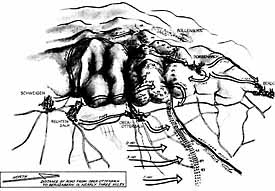
| Sketch approximates terrain which figured in battle through
Siegfried. The 36th's lead columns, approaching from Schweigen and Rechtenbach, first
tried for a quick opening in the flatland but were strongly rebuffed. Other elements took
to the hills and began slow reduction of hidden pillboxes. Then the critical Grassberg
height was seized and the attack pressed until Dorrenbach was entered, at the rear of the
enemy's main line. Bergzbern fell on the following day. Long supply route across mass of
hills had to be cleared and built. Click
on the map to view a larger image. |
|
C Company grouped three times before
pushing down into Ober-Otterbach where, even after the town was cleared, the enemy
continually strafed the streets from pillboxes on the nearby hills. The remainder of the
1st Battalion closed into Ober-Otterbach soon after dark and hastily prepared for a direct
assault through the dragon's teeth to the front.
Meanwhile, other battalions of the Division were
moving up to strike at other points along the Siegfried belt. The 2nd Battalion, 142nd,
veered to the left of the 1st Battalion, clambering over the line of hills until heavily
engaged in the mass of pillboxes west of Ober-Otterbach. Deep into the hills on a wide
sweep to the left went Lt. Col. Everett S. Simpson's 3rd Battalion, 142nd.
In the flatland on the Division right, the 2nd
Battalion, 141st, had crossed into Germany southeast of Wissembourg at 1100 hours of March
19--first unit of the Division over the border. By nightfall the 2nd Battalion had formed
a line in front of the dragon's teeth one mile east of Ober-Otterbach
and in early probings uncovered an array of 15 enemy machine-guns alert to meet it.
During the night the 3rd and 1st Battalions, 141st, hastened up to move in alongside the
2nd on the 2nd's right. Six battalions, reading from left to right: the 3rd, 2nd, and 1st
of the 142nd, the 2nd, 3rd, and 1st of the 141st, now lined up before the Siegfried. The
143rd remained, for the time, in Division reserve.
Next morning it became certain that a penetration
would not be made in the lowland. The 1st Battalion, 142nd, found the enemy forces at the
dragon's teeth beyond Ober-Otterbach too strong for any quick overthrow, withdrew to the
cover of the town before daylight. The three battalions of the 141st lunged forward on a
broad front at noon but soon were pinned down by heavy concentrations of nebelwerfer fire
and of crossed machine-gun fires in the open terrain. Leaving only a token force to
maintain enemy contact, the main body of the 141st was then withdrawn and turned to
support the Division effort in the hills.
WAY OPENED
A break by the 3rd Battalion, 142nd, in capturing
the Grassberg height, a critical feature in the enemy's defense, paved the way for the
eventual collapse of the Siegfried Line in the Division zone.
| A twelve-hour march uphill west of Rechtenbach
brought the 3rd Battalion in position before the Grassberg height at noon of March 20. A
deep draw running west from Ober-Otterbach formed a moat-like barrier to the base of the
Grassberg ridge. In the draw and on the slopes of the objective, the Germans had felled
large numbers of trees to provide ample fields of fire and to erect another obstacle. Men
of the battalion scampered across the draw at its narrowest open stretch, dodging the
long-range shots of a single enemy machine-gunner taking aim from the head of the draw. |
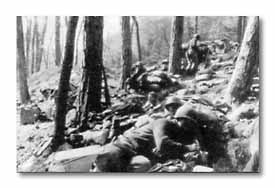
| Hot coffee revives radio team in Siegfried operation. |
|
While the Battalion was thus hoping
to effectively attain surprise, an incident occurred that should have touched off the
whole German defense. Unknown to the Battalion commander, the leading platoon of the
Battalion, from I Company, attacked the Grassberg hill before the main body was able to
follow up in strength. The platoon succeeded in gaining the top but was driven off by
fierce counter-action after the platoon leader was killed. The result was learned by
Colonel Simpson as he directed the infiltration of the main body across the draw.
Yet, after the 3rd Battalion had struggled up over
the log barriers and the steep slope, the men were able to drive the Germans
from the forward edge of the top and establish themselves in the trenches about the
pillboxes. Fighting was brisk until Grassberg was secured by late afternoon. After dark
Germans attempting to filter back onto the hill from a nearby ridge were severely cut
down.
Now it was imperative to exploit the advantage won,
but the 3rd Battalion, still engaged and short on ammunition, could not move. The route
that the 3rd Battalion had taken to reach its objective was a matter of 12 to 16 hours'
march. For the nearest available battalion, the 1st, the round-about way from
Ober-Otterbach would have required at least 20 'hours, and exhausted the men before
fighting.
SHORT ROUTE SUCCEEDS
At 2200, Colonel Lynch ordered Lieutenant Colonel
James Minor, commanding the 1st Battalion, to move to Grassberg and pass through the 3rd
Battalion. But the move was to be made boldly up the deep draw due west from
Ober-Otterbach under the very eyes and ears of the enemy in his defenses north of the
draw. This short route, covered without stirring the enemy, enabled the 1st Battalion to
arrive on Grassberg and jump off through the 3rd Battalion at 0715 on March 21.
| The fighting was bitter all during the day as
successive pillboxes were slowly reduced. Suddenly, during late afternoon, Company B broke
loose and crashed down into Dorrenbach, a town at the rear of the German line, routing
surprised kitchen crews And artillerymen. Following the 1st Battalion, 142nd, the 1st
Battalion, 143rd, passed through to attack toward Bergzabern. Pushing on in the deep woods
during the night and meeting continued resistance, the battalion at daylight found itself
1,500 yards south of Dorrenbach, 180 degrees off-course. They had been fighting the German
main line from the rear! In the morning the 2nd Battalion, 143rd, joined in the advance on
Bergzabern. It fought to cut the Bollenborn-Bergzabern road, then with the 1st Battalion
on the right, pressed into Bergzabern after dark. By morning the outer defenses of the
town had crumbled, the enemy's artillery fire over the Siegfried had ceased, and the
Germans who had not been able to flee were giving themselves up by the hundreds. |
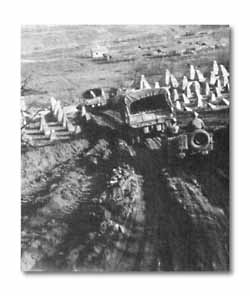
| Through the broken Siegfried . . . |
|
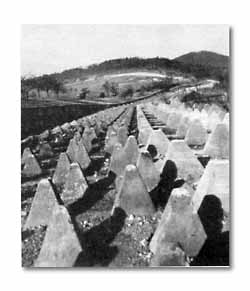
| . . . rolled a victorious 36th. Dash to Rhine followed. |
|
Though a description of the breakthrough pattern
deserves special attention, other battalions on the Division front contributed powerfully
to the over-all success by whittling down German forces adjacent to the penetration. Men
of the 2nd Battalion, 142nd, awoke on the morning of March 20 to find themselves locked in
the midst of a maze of related pillbox fortresses on the hills west of Ober-Otterbach.
Through the entire operation the battalion was engaged in clearing them one by one until
fifty-four had been captured. Infantrymen and engineers tackled the pillbox problem in
careful coordination. Tanks could not come within range because of the steepness of the
slopes on which the defenses lay. Infantry cut the wire that hemmed in the
defenders, chased the Germans from their trenches into the cover of the concrete
enclosures, then kept these buttoned-up under fire while the engineers crept up to lay
special demolition charges at doors and apertures. A sharp blast and the enemy might come
running out in surrender. Or, safely under cover, he might counter by calling down mortar
fire on his own position. Each strongpoint presented its own trying problem. The 1st
Battalion, 141st, moved in on the right of the 2nd Battalion, 142nd, on March 21, and had
cleared thirty-five of the strongboxes by the time opposition ceased. |
SUPPLY
TRAIL NEEDED
The 3rd Battalion, 143rd, and the 3rd Battalion,
142nd, fought to open a supply trail to Dorrenbach after the breakthrough at Grassberg had
been achieved. When the main effort of the Division was directed into the hills it
necessitated the opening up and construction of a supply route for the troops advancing on
Bergzabern, as none other existed in the Division sector. When completed the trail wound
seven and a half kilometers from Rechtenbach to a point near Bollenborn. Over it all of
the Division armor and transport passed until the main road through the dragon's teeth to
Bergzabern was cleared.
| Enemy artillery, rocket fire, and six-barrelled
mortars were very active during all of the Siegfried operation. Two nebelwerfer regiments
showed up in the prisoner toll. Our own artillery countered just as heavily, but the
Germans were relatively secure in their heavy emplacements. With the Siegfried floodgate opened wide our forces rushed into
Germany to rapidly mop up remaining resistance west of the Rhine River. The 143rd,
in the lead, thrust due east from Bergzabern early on the morning of March 23, seizing
Kappellen and Barbelroth. Leap-frogging through the 1st and 2nd Battalions, the 3rd
Battalion, 143rd, first to be motorized, opened the road to Winden. By this time
straggling groups of Germans were being overrun in great numbers. Resistance was
negligible and, if at all, only hastily organized. The 4th Provisional Battalion (Colonel
Denholm's specially created task force made up principally of Cannon and Anti-tank company
elements) rolled through the 3rd, destroyed more serious German opposition at Minfeld,
then pushed another fifteen kilometers beyond to search Neupfotz at 1645 hours. Here a
large body of the enemy was overtaken before they could escape across the Rhine.
Some 700 prisoners were rounded up, a battery of 170mm. horse-drawn artillery, a light
tank, scout car and other equipment captured. Before dawn of March 24 the 143rd had seized
Leirnersheim, on the Rhine, and the ferry sites which were its objective.
|
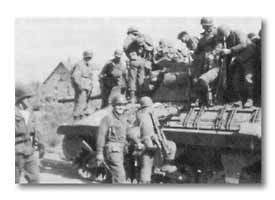
| Troops mounted tanks and tank destroyers at Bergzabern. |
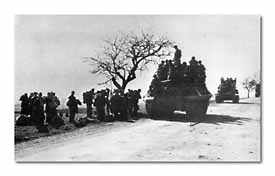
| On March 23rd tank columns raced 25 miles to the Rhine, rounded up
hundreds of fleeing Germans. |
|
Meanwhile, on a parallel route to
the north, the 142nd, which had hastily removed from its Siegfried positions and had
motorized the 1st Battalion at Bergzabern, moved out at 1330 to race to the Rhine in
pursuit of the fleeing enemy. At Rohrbach, the column came upon a 14th Armored Division
team on the same road and heading for the same objective, Hordt. But it was then held up
by enemy resistance before Herxheim. Turning southward to by-pass both the resistance and
the congestion of friendly elements on the same road, the 142nd drove twenty-five
kilometers to gain its objective, ahead of the friendly team, soon after midnight, with
one sharp skirmish in the dark at Kuhardt.
The Division was now drawn up along the Rhine. The
clearing of the marshy, wooded fringes of the west bank occupied another two days. Within
a week other Allied troops would be storming across and driving deep into German
heartland. The battle at the Siegfried was the last great battle the 36th would have to
face.
|